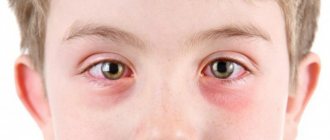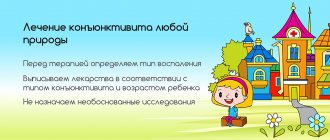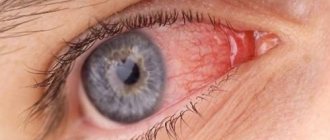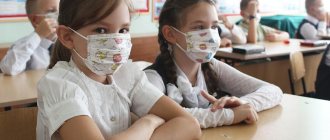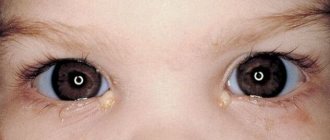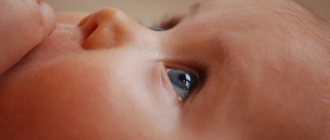Among childhood diseases, conjunctivitis of various etiologies, from bacterial to viral, occupies a prominent place. Very often they are accompanied by a symptom such as rhinitis, or, more simply, a runny nose. In what cases is conjunctivitis in a child combined with the appearance of snot and what treatment is required?
In this article
- Pharyngoconjunctival fever: symptoms
- Treatment of pharyngoconjunctival fever
- Follicular herpetic conjunctivitis
- Treatment of follicular herpetic conjunctivitis
- Conjunctivitis and purulent snot in a child with measles
The simultaneous manifestation of snot and conjunctivitis in a child of any age should alert parents. In this case, you should definitely show it to the doctor, because it is a mistake to think that conjunctivitis can appear in a child from snot. These two symptoms may be either a coincidence or a manifestation of one of the serious diseases that require appropriate treatment so that conjunctivitis does not cause complications.
What are adenoviruses
These are common pathogens of viral pathologies. Adenoviruses were first isolated in the 50s of the 20th century, and today 54 types of adenoviruses pathogenic for humans are known in medical practice, which are divided into 7 groups.
These microorganisms are very tenacious. They can remain active for up to 2 weeks on dirty surfaces, and die only when heated to 56 degrees, when treated with chloramine or heated with ultraviolet light. In addition, viruses are easily transmitted by airborne droplets and household contact, which is why diseases caused by them become epidemic. The main part of adenoviruses causes upper respiratory tract infections: acute respiratory viral infections, influenza, and are also often the cause of conjunctivitis, tonsillitis, otitis media and other ailments. Children under 6-7 years of age are most susceptible to adenoviruses. Their immunity is too weak and is not able to resist the virus that has entered the body too actively. If signs of illness are detected in a child—fever, cough, runny nose—urgent therapeutic measures must be taken. According to medical statistics, adenoviral infections in children under six years of age account for up to 30% of cases of all viral illnesses. In this case, conjunctivitis is a common complication against their background.
Here are some diseases that can cause eye inflammation:
- influenza, parainfluenza;
- ARVI is an acute respiratory viral infection (there are up to 200 types);
- nasopharyngitis;
- acute respiratory diseases, etc.
What symptoms accompany viral infections in adults and children?
Ailments of this type have characteristic signs that indicate a viral etiology. They usually begin with an increase in temperature, in some cases it reaches 39°C. They are also accompanied by the following manifestations:
- weakness and lethargy in the muscles;
- severe cough and runny nose, nasal congestion with copious discharge;
- sore throat, pain when swallowing;
- swelling of the tonsils with the appearance of a whitish purulent coating on them;
- lacrimation, swelling and hyperemia of the conjunctiva, pain in the eyes;
- loss of appetite;
- enlarged parotid and cervical lymph nodes.
In terms of external signs, ARVI and influenza are quite similar, but they have differences. Thus, with acute respiratory inflammation, the symptoms are quite pronounced. The eyes become very red and itchy, and there is a feeling of “sand” in them. The second distinctive feature of colds is their rapid development: the period of acute intoxication usually lasts 1-2 days, while with the flu, negative symptoms can last up to 7 days or longer. Another characteristic sign of ARVI is the duration and course of the fever. The temperature can rise to 39°C on the first day, but it does not last long and soon declines. With influenza, high fever and fever may persist for a week, despite therapeutic measures taken. From the first day of illness, when adenovirus infection occurs, conjunctivitis and a severe runny nose become its companions. Abundant transparent discharge appears from the nose, which can soon take on a mucopurulent character. It becomes difficult to breathe, the nose becomes blocked, and the patient is forced to breathe through the mouth. The tonsils and pharynx swell and turn red, a strong cough develops, first dry, and after 3-4 days expectorating with sputum.
Conjunctivitis is a “companion” of adenoviral infection
This is what ophthalmologists themselves call this complication of ARVI and influenza. With the development of these diseases in children and adults, concomitant inflammation of the eyes almost always begins. The conjunctiva turns red and swells, severe itching and burning begins, lacrimation begins, there is a sensation of a foreign body in the eyes, irritation from bright light, some types of viral conjunctivitis are characterized by clouding of the cornea and decreased clarity of vision. In the case of a prolonged course of a cold or flu, a bacterial infection may accompany it, and then purulent discharge from the eyes will be added to the symptoms of viral conjunctivitis.
In such a situation, treatment will take a longer period. Doctors constantly remind: if any unpleasant sensations appear in the organs of vision, you need to visit a specialist to find out the cause, and not look for advice on forums or self-medicate. These are the types of conjunctivitis as complications that can occur against the background of adenoviral infections.
How to treat
Treatment tactics are determined strictly on an individual basis. Self-therapy, in this case, is unacceptable. The main task is to eliminate the pathogen that provoked the development of the disease.
Medicines
If the disease is of bacterial origin, antibacterial therapy is recommended. To eliminate green snot, the doctor may prescribe vasoconstrictor drops, which will help the baby get rid of nasal congestion.
Such drugs should be used with extreme caution, since they have a fairly large number of side effects. Therefore, they can be used only as prescribed by a specialist who will take into account all the individual characteristics of the child’s body.
Washing
In addition, the doctor may recommend performing procedures for rinsing the nasal passages with saline solutions. Such products are widely available in pharmacies and can be used without fear even in infants, since they contain only microelements and substances from natural sea water.
Microclimate
Medicines that soften the mucous membrane will help eliminate a child’s cough. Also, if green snot accompanies a cough, parents should ensure optimal drinking regimen and monitor air humidity.
If pus is released from the eyes due to a cold, emergency care is not required. As a rule, rinsing of the affected eye is prescribed. For this purpose, decoctions of medicinal herbs such as chamomile or sage are used. The product can be prepared as follows: 1 tbsp. a spoonful of dry grass is poured into 1 tbsp. boiling water
Microclimate
Medicines that soften the mucous membrane will help eliminate a child’s cough. Also if green snot accompanies a cough. Parents must ensure optimal drinking conditions and monitor air humidity.
Green snot must be treated. Green snot in a child is an advanced runny nose, so treatment will not be as fast or as easy as we would like. But only determination and fulfillment of all points will lead to recovery.
First, you need to create a comfortable microclimate with cool, moist air in the children's room; regularly, 5–12 times a day, clean and wash the child’s nose from accumulated thick green mucus; if there is no temperature, the child needs to walk more.
Nasal rinsing
Treatment of green snot should begin with rinsing the nose with saline solutions. Saline solutions thin mucus, facilitate its release, and have a bactericidal and anti-inflammatory effect.
For young children, we recommend using isotonic saline solutions - a salt concentration of 0.9%; for older children, you can try hypertonic solutions - a salt concentration of up to 2.4%.
A hypertonic solution better separates mucus from the walls of the nose and copes with nasal congestion faster. For rinsing, you can use saline solution or dissolve a teaspoon of sea salt in a liter of boiled water; to better thin the mucus, you can add soda.
For children over 3 years old, the nose can be washed with antiseptics - Furacillin solution or Sodium Sulfacyl.
Cleaning the nose
After rinsing, the nose should be thoroughly cleared of secretions. For newborns and toddlers, you can use a syringe, a cotton swab, or mechanical or automatic snot aspirators. Children over 2 years old should be taught to blow their nose.
Please note that when a child is sick and has a runny nose, a lot of earwax is released in the ears. It is impossible to properly clean the ears with a cotton swab; it can damage the eardrum. Therefore, ENT doctors recommend that children who have a cold and often get sick during illness clean their ears with hydrogen peroxide.
Cleaning your nose and ears means speeding up your recovery by half.
Astringent drops
Very often, parents are faced with the difficulty of putting medicines in their children’s noses and clearing it of green snot - the children turn out and do not allow it to be cleaned. Astringent nasal drops are the most reliable and effective remedy that helps quickly cure a baby of stringy green snot.
This is, first of all, Protargol - a silver colloid dissolved in water. They are very cheap, prepared in a pharmacy - 1% solution for newborn children, 2% solution for older children.
Protargol has an astringent effect, silver ions penetrate bacteria and immediately destroy them, the antiseptic and anti-inflammatory effects of the drug are also described. The drug slightly constricts blood vessels, so it immediately restores nasal breathing. Protargol is safer than antibiotics and can even replace them.
Analogues – Collargol, Sialor (tablets for preparing a solution). Drop into the nose – 1 week.
These drops can only be used if your nose is stuffy. For children under one year old, you can use drops containing Xylometazoline, from 6 months Phenylephrine. After a year, you can add Naphazoline drops; from the 3rd year of life, drops containing Oxymetazoline are allowed.
Why is it important to get rid of swelling - swollen mucosa blocks the junction of the sinuses with the nasal cavity, which can lead to sinusitis. Elimination of edema is the prevention of otitis media.
Antibiotic
For sinusitis or other types of sinusitis, the prescription of an antibiotic is indicated as the most reliable drug for treating a runny nose. In mild cases, the disease can be treated with Isofra nasal drops or Polydex combination spray.
In more severe situations, the antibiotic is indicated for oral administration - Amoxicillin, Amoxicillin-clavunate, Cefotaxime, Ceftriaxone; if the above are ineffective, treatment is carried out with Sumamed. Young children can drip sodium sulfacyl into the nose; it is a more harmless drug compared to antibiotics.
An ENT doctor can write a prescription for preparing complex nasal drops. Complex drops are prepared in saline solution and contain vasoconstrictor, antibacterial and hormonal/antihistamine components.
We invite you to familiarize yourself with an effective remedy for cataracts - All about eye problems
An untested, but often highly effective means of treating and preventing green discharge are homeopathic preparations - Sinupret, Sinuforte, Euphorbium compositum, EDAS and others. They are created only from natural ingredients, therefore they have no contraindications, are completely safe, and do not have side effects.
There is no need to prescribe antiviral drugs to newborn children with green nasal discharge. They are effective only against viruses, but do not have a positive effect against bacteria, so suppositories are given to the child no later than 3 days from the onset of the disease.
Physiotherapy
Bioptron of the nose, UV radiation of the nose, Electrophoresis with medicine Inhalation over a salt lamp.
The child's body is very vulnerable and susceptible, so traditional methods of treatment are not recommended. It is prohibited to treat allergic children suffering from bronchial asthma using traditional methods.
The safest home remedies are inhalations over a decoction of chamomile with soda, boiled potatoes in their jackets. Children of middle school age and older can drip aloe and Kalanchoe juice into their nose.
Freshly squeezed carrot juice works well to remove thick mucus from the nose; for children under 3 years of age it should be diluted twice with boiled water. The juice has an astringent and irritating effect, as a result the child sneezes out all the accumulated mucus.
To prevent the onset of the disease, you need to treat a runny nose in time and not let the cold develop. An important point is to rinse the nose with saline; we recommend doing this procedure for various forms of runny nose, at all its stages.
Once the cause is determined, you can begin to fight the pathology. If problems arise in determining the nature of the pathogen, a series of laboratory tests are prescribed.
Conjunctivitis with a runny nose in a child should be treated comprehensively. Medicines are indicated for internal and external use.
Any therapy involves the use of drops in the nose and eyes. For congestion, Otrivin, Nazivin are prescribed, but not longer than 5 days, preferably at night, so as not to cause addiction.
Rinsing will help to quickly cope with the symptoms of rhinitis and conjunctivitis. Saline solutions are perfect for the nose, and decoctions of chamomile and calendula can be used for the eyes. If the child is over 2 years old, then it is allowed to rinse with 2% boric acid or Furacilin. It is advisable to carry out the procedure 3-4 times a day.
If the risk of complications increases or a bacterial infection occurs, then you cannot do without taking antibacterial agents. In the treatment of children, it is allowed to use the antibiotic Flemoklav, Sumamed, Fromilid. The drugs are available in the form of a sweet suspension, so giving it to a child will not be difficult.
If you choose the wrong medications to treat eye inflammation, you can wait a long time for a positive effect. The choice should always depend on the origin of the disease.
If conjunctivitis is of viral etiology, then the child is advised to take interferon-based drugs that strengthen the immune system. Antiseptic solutions are suitable for washing the eyes to prevent bacterial infection.
If bacterial conjunctivitis occurs, then Albucid and Tobrex should be instilled into the eyes. Polydex can be used for a runny nose, but only for children over 2.5 years old; Isofra is also great. Drops based on Miramistin, for example, Okomistin, have proven their effectiveness.
Catarrhal superficial conjunctivitis
The catarrhal form of eye inflammation must be treated in a timely manner, since its consequences pose a danger to vision. The disease is characterized by copious discharge from the eyes, from which the eyelashes stick together, and there is also noticeable swelling of the eyelids and redness of the mucous membrane. Here are some manifestations that may indicate that the patient has developed catarrhal purulent conjunctivitis:
- burning, itching in the eyes;
- increased sensitivity to daylight or artificial lighting;
- copious discharge in the form of cloudy mucus with flakes;
- corneal ulceration;
- hyperemia and swelling of the mucous membrane and surrounding tissues;
- blepharospasm (incomplete closure of the eyelids).
For this type of conjunctivitis during ARVI, antiviral drugs are prescribed to help eliminate symptoms. In addition, the disease itself, against which it developed, is also treated. With timely consultation with a doctor, compliance with the course of therapy and hygiene rules, catarrhal conjunctivitis is successfully cured in 2 weeks; in the chronic form, the process can last for 30-40 days. However, in some cases, when the start of treatment is delayed or the patient does not comply with the doctor’s instructions, negative consequences may occur:
- blepharitis (bilateral inflammation of the eyelids);
- keratitis, dry eye syndrome;
- a large accumulation of pus in the lower part of the organ of vision;
- inflammation of the middle ear;
- deformation of the eyelids.
Catarrhal conjunctivitis is a dangerous eye disease that requires responsible and timely treatment. An individual approach is required for each specific case. The wrong medicine can make the situation worse. The signs of catarrhal conjunctivitis against the background of ARVI in a child are identical to the general symptoms in adults.
The only difference is that in childhood the disease, as a rule, has a more acute course: more mucous discharge, damage to both eyes, severe swelling of the lower eyelid, however, it is more easily tolerated than in adults. Full recovery occurs within 7-14 days, with symptoms persisting for a week.
Conjunctivitis and purulent snot in a child with measles
A disease such as measles is also accompanied by symptoms including conjunctivitis and runny nose. The measles virus spreads through airborne droplets and usually affects preschool children who have not been vaccinated. With this disease, at the initial stage - a catarrhal period that lasts from 4 to 7 days - the symptoms resemble a severe cold, complicated by conjunctivitis. The disease begins acutely: the temperature rises, which can reach 38–39°, and a runny nose appears. The condition is aggravated by a dry, obsessive cough, which gets worse every day. Symptoms of conjunctivitis are added: the conjunctiva of the eyelids becomes swollen, white spots with a red rim form on it, sometimes the child experiences photophobia, blepharospasm (involuntary closure of the eyelids). In some cases, purulent discharge is present. A complication of conjunctivitis can be keratitis with corneal erosions.
This condition requires immediate contact with a pediatrician, who will prescribe adequate treatment.
First of all, it should be aimed at treating the underlying disease: measles. Treatment of conjunctivitis directly in viral diseases has much in common:
- Antiseptic solutions are used (nitrofural or ethacridine (rivanol) diluted in a ratio of 1:5000 or sulfacetamide solution).
- Nonspecific immunotherapy drugs: instillation of interferon/recombinant interferon alpha-2b, carried out every 2–3 hours; or interferonogens (“Poludan®” or “Aktipol®”), carried out up to 8 times a day.
- In case of corneal damage, regenerating drugs are prescribed: Taurine-AKOS, Solcoseryl or Korneregel.
- Anti-measles γ-globulin is used in injections or drops, and vitamin therapy is used.
An important point in the treatment of conjunctivitis, which is accompanied by catarrhal manifestations, including snot in a child, is the correct diagnosis. Therefore, you should not delay calling a doctor.
Membranous conjunctivitis
This type of disease is less common than others and has some distinctive features. Grayish-white films form on the mucous membrane, which should be removed with a cotton swab. Usually they are separated without problems, however, if they are already tightly fused to the conjunctiva, then when removed, the surface may become damaged and begin to bleed. After a course of treatment and elimination of the symptoms of conjunctivitis, scars sometimes remain on the mucous membrane. It happens that this disease is confused with diphtheria.
Epidemic keratoconjunctivitis
Epidemic keratoconjunctivitis is a complication of adenoviral or bacterial infection. Patients first complain of a sensation of a foreign body in one eye, and then these manifestations are accompanied by swelling of the eyelids, redness of the mucous membrane of the eyelids, profuse lacrimation, itching, photophobia, and deterioration in clarity of vision. After a few days, signs of epidemic keratoconjunctivitis, as a rule, spread to the second eye (in 70% of cases).
A distinctive sign of keratoconjunctivitis, which represents the main danger in advanced cases, is clouding of the corneal tissue. This occurs due to the accumulation of infiltrates in the superficial, conjunctival layers. At the same time, these formations can dissolve over a fairly long period, sometimes up to a year or more. At this time, visual acuity noticeably decreases, so that sometimes a person is forced to temporarily leave their usual activities.
Emergency help
If the child produces pus profusely, rinsing with a solution of furatsilin or potassium permanganate may be prescribed. The procedures should be performed several times at a time, and both eyes must be washed at once, even if only one of them is festering.
Green snot, which accompanies coughing and suppuration of the eyes, cannot be ignored, since this condition not only causes a lot of discomfort to the child, but can also lead to the development of unwanted complications.
Conjunctivitis due to influenza
Another acute upper respiratory tract disease caused by the influenza virus. It also belongs to the ARVI group, often spreading in the form of epidemics and pandemics. The influenza virus has the ability to constantly mutate. Every year new serotypes appear. Currently, about 2000 varieties of this disease have been identified. Signs of influenza are often similar to those of acute respiratory viral infections: cough, fever, mucus from the nose. However, there is still a difference. It is the correctly identified symptoms of influenza infection that will help cure it faster.
- With ARVI, the temperature rarely rises above 38°C and usually goes away within 2 days, but with the flu it can reach 39-40°C and last up to a week, especially in children.
- Lethargy, weakness and muscle aches, fever, profuse sweating, eye pain, headache, aversion to daylight or artificial light.
- Swelling of the nasal cavity. With ARVI, a runny nose lasts throughout the entire period of the disease, accompanied by copious nasal discharge, and with influenza there is usually only slight congestion in the sinuses.
- The mucous membranes become inflamed in different ways during colds and flu: with ARVI, the throat and nose turn red, with flu - the back wall of the pharynx and the soft palate.
- A severe cough, first dry, then with sputum, is characteristic of both diseases.
- Inflammation and redness of the mucous membrane of the eyes is more typical as a complication of ARVI, however, this is also a common occurrence with influenza. A runny nose and cough, along with conjunctivitis, are three main signs of viral diseases.
Viral conjunctivitis with influenza is a rather dangerous condition, as complications may arise in the form of optic neuritis or keratitis. The inflammatory process in the eyes can develop within a few days after recovery.
Treatment of viral conjunctivitis in ARVI and influenza
drops and ointments with interferon. When treating any type of conjunctivitis - viral, bacterial, allergic - it is necessary to wash the eyes before administering medications. To do this, you can use weak solutions of various products: boric acid, furatsilin, or special products - for example, “Blefarolion” from the Russian.
Procedures should be carried out with pre-washed hands to avoid introducing dirt. You need to wash your eyes about 5-6 times a day, and then administer drops or ointments. Conjunctivitis is a disease that, if not treated correctly, can lead to many unpleasant consequences for the visual organs. In this case, you should not self-medicate, but strictly follow the doctor’s instructions. If visible improvement in eye condition does not occur within 2-3 days, you should not continue taking the medicine. Contact your specialist again - he will prescribe another remedy. So, how to treat viral conjunctivitis?
Additional diagnostics
Additional methods will help determine the cause of inflammation in the nose and eyes. After a medical examination, sick children are sent for diagnostic procedures:
- General blood analysis.
- Analysis of discharge from the nose and eyes (cytology, culture, PCR).
- Serological tests (ELISA, RSK, RNGA).
- Rhinoscopy.
- Dacryocystography.
- Radiography.
A consultation is required not only with an ENT doctor, but also with an ophthalmologist. And based on the results of a comprehensive examination, it will become clear what the problem is and how best to eliminate it.
General blood analysis. Analysis of discharge from the nose and eyes (cytology, culture, PCR). Serological tests (ELISA, RSK, RNGA). Rhinoscopy. Dacryocystography. Radiography.
Antiviral drugs: drops
We will provide a short overview of medications that are used in modern ophthalmology to treat conjunctivitis in adults and children. "Poludan" - drops that accelerate the synthesis of interferon in the body, which allows it to actively resist viruses. Improvements from the use of drops are noticeable already on the third day. "Ophthalmoferon" with interferon lingers longer in the eye tissues, which increases the effectiveness of antiviral therapy. It is well tolerated even by children and does not cause side effects. "Actipol" - antiviral drops that can quickly eliminate swelling of the conjunctiva and restore damaged corneas. Since the drug is applied topically, its active component - aminobenzoic acid - is well absorbed into the tissue and has a quick effect. "Albucid" is the most common drug that suppresses many pathogenic microorganisms. It is used to treat conjunctivitis even in newborns. The advantages of drops are affordable cost and maximum effectiveness at the onset of the disease.
Treatment of conjunctivitis with ointments
In addition to drops, the doctor may also prescribe antiviral ointments. Thus, Tebrofen with a concentration of 0.5% is used to effectively eliminate the symptoms of adenoviral conjunctivitis. The ointment is quite common due to its affordable price and effective pharmacological action. Analogues of tebrofen ointment are the drugs “Viferon”, hyporamin ointment, “Acyclovir” and others.
The use of Bonafton alleviates the symptoms of eye inflammation, reduces redness of the conjunctiva, and improves the healing of corneal ulcers. When treating adenoviral, bacterial and allergic forms of conjunctivitis, it is very important to promptly consult a specialist who will determine the true cause of the disease and prescribe a competent treatment regimen. A disease in an advanced stage can become chronic, and it will be much more difficult to cure. In addition, some types of conjunctivitis can seriously affect the condition of the visual organs. Remember, our health largely depends on our attitude towards it.
Treatment tactics
Chamomile decoction and green tea can serve as an antiseptic
If a child has a runny nose and discharge of pus from the eyes, the doctor must conduct a full diagnosis and determine the cause of this condition. You need to be especially careful with children, because due to a weak immune system, many pathognomonic symptoms of a particular disease may be mild or completely absent.
All therapeutic measures are aimed at eliminating the underlying disease. For bacterial conjunctivitis, it is advisable to prescribe antibacterial agents in the form of eye drops. We must not forget about washing.
Special mention should be made of the treatment of allergic conjunctivitis. In addition to taking antihistamines, it is necessary to minimize the exposure of the baby to the allergen. Under no circumstances should you choose medication for your child on your own!
